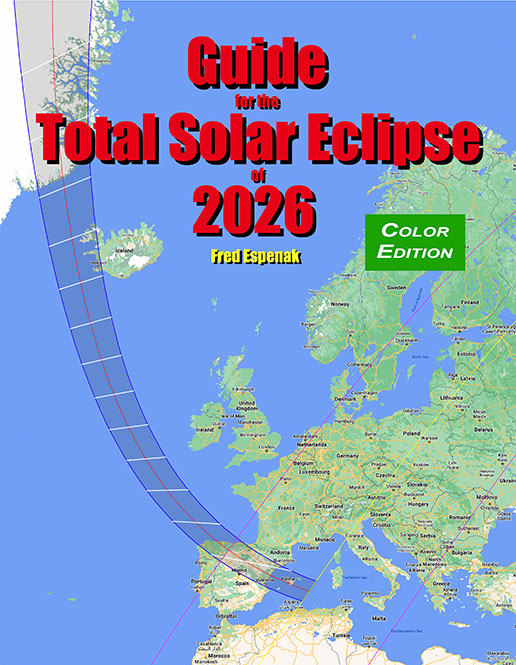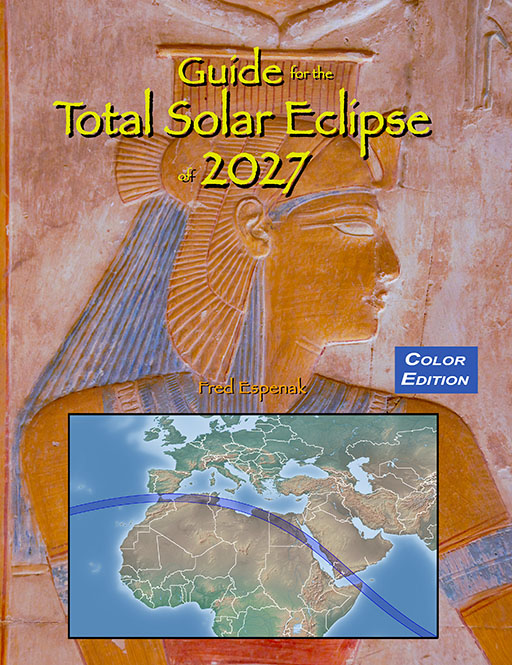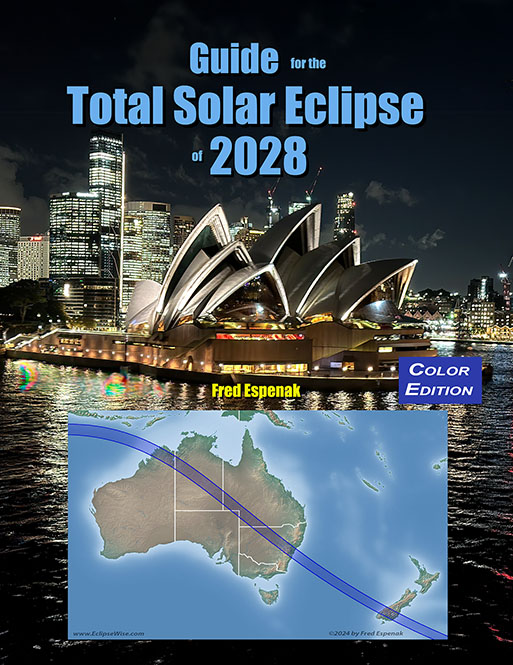Eclipses During 2025
By Fred Espenak
Based on the Article Published in
Observer's Handbook 2025,
Royal Astronomical Society of Canada
In 2025, there are 2 solar eclipses and 2 lunar eclipses:
| Eclipses During 2025 | |||
| 2025 Mar 14: Total Lunar Eclipse | |||
| 2025 Mar 29: Partial Solar Eclipse | |||
| 2025 Sep 07: Total Lunar Eclipse | |||
| 2025 Sep 21: Partial Solar Eclipse | |||
| Eclipses During 2025 | |||
|
Total Lunar Eclipse 2025 Mar 14 
|
Partial Solar Eclipse 2025 Mar 29 
|
Total Lunar Eclipse 2025 Sep 07 
|
Partial Solar Eclipse 2025 Sep 21 
|
World maps show the regions of visibility for each eclipse. The lunar eclipse diagrams also include the path of the Moon through Earth’s shadow. Contact times for each principal phase are tabulated along with the magnitudes and geocentric coordinates of the Sun and the Moon at greatest eclipse.
Unless otherwise stated, all times and dates used in this publication are in Coordinated Universal Time or UT [1]. This astronomically derived time system is colloquially referred to as Greenwich Mean Time or GMT. To learn more about UTC and how to convert UTC to your own local time, see Time Zones and Universal Time.

Click for larger more detailed figure
Total Lunar Eclipse of 2025 Mar 14
The first eclipse of the year is a total lunar eclipse occurring at the lunar orbit’s descending node near the border between Leo and Virgo. It occurs 3.4 days before apogee (Mar 17 16:38 UTC). Consequently, the apparent diameter of the Moon (29.8 arc-minutes) is smaller than its mean diameter (31.1 arc-minutes).
The Moon passes through the northern part of Earth’s umbral shadow as shown in Figure 1. The times of the major eclipse phases are as follows.
Penumbral Eclipse Begins: 03:57:12 UTC
Partial Eclipse Begins: 05:09:25 UTC
Total Eclipse Begins: 06:26:00 UTC
Greatest Eclipse: 06:58:47 UTC
Total Eclipse Ends: 07:32:04 UTC
Partial Eclipse Ends: 08:48:21 UTC
Penumbral Eclipse Ends: 10:00:34 UTC
At the instant of greatest eclipse[7] (06:58:47 UTC), the Moon lies at the zenith for a point in the Pacific Ocean about 1800 kilometers south of Mexico. The entire event is visible from most of North America, South America, and the Pacific Ocean. None of the eclipse will be visible from eastern Europe, eastern Africa, Asia, or western Australia.
The umbral eclipse magnitude [8] peaks at 1.1804 as the Moon’s southern limb passes 4.1 arc-min north of the shadow’s axis. In contrast, the Moon’s northern limb will lie 5.5 arc-min from the northern edge of the umbra and 33.9 arc-min from the shadow’s center. Thus, the northern sections of the Moon will appear much brighter than the southern part, which will lie deeper in the shadow. Since the Moon samples a large range of umbral depths during totality, its appearance will likely change dramatically over time. However, it’s impossible to predict the exact brightness distribution in the umbra, so observers are encouraged to estimate the Danjon value at different times during totality (see Danjon Scale of Lunar Eclipse Brightness). Note that it may also be necessary to assign different Danjon values to different portions of the Moon (i.e. north vs. south).
The Moon’s brightness during totality can be easily estimated using a pair of binoculars (see Moon's Apparent Magnitude During Total Lunar Eclipsess).
Table 1 lists predicted umbral immersion and emersion times for 25 well-defined lunar craters. The timing of craters is useful in determining the atmospheric enlargement of Earth's shadow (see Crater Timings During Lunar Eclipses).
The March 25 eclipse is the 53rd eclipse of Saros[6] series 123. The series is composed of 72 lunar eclipses in the following sequence: 24 penumbral, 6 partial, 25 total, 8 partial, and 9 penumbral eclipses (Espenak and Meeus, 2021b). Saros 123 spans 1280.1 years and runs from the years 1087 to 2367.
Complete details for Saros 123 (including all eclipses in the series) can be found at Saros 123.
For more information about this eclipse, see the EclipseWise Prime Page at Total Lunar Eclipse of 2025 Mar 14
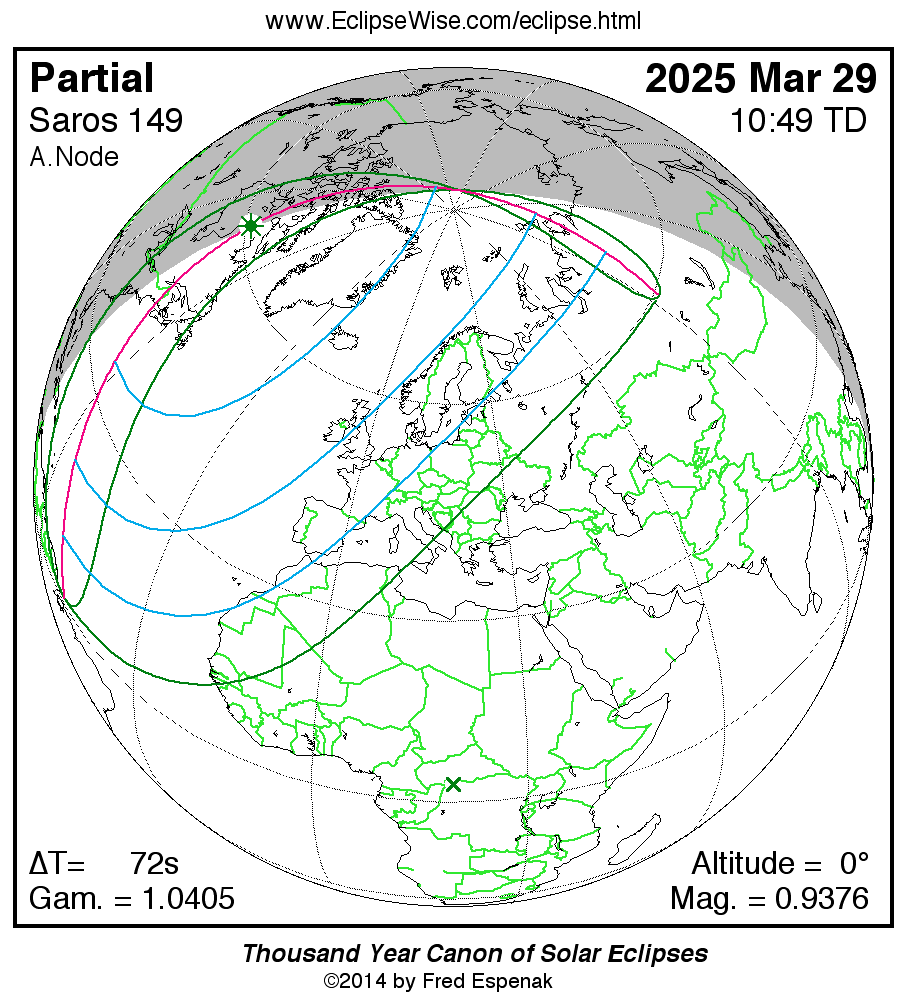
Click for larger more detailed figure
Partial Solar Eclipse of 2025 Mar 29
The first solar eclipse of 2025 is a Northern Hemisphere event visible from northeast USA and Canada, Europe, northwest Africa, and northern Russia (Figure 2). Greatest eclipse [2] takes place at 10:47:27 UTC when the eclipse magnitude [3] reaches 0.9376. The contact times of the Moon’s penumbral shadow with Earth are as follows:
Partial eclipse begins: 08:50:43 UTC
Partial eclipse ends: 12:43:45 UTC
Local circumstances for dozens of cities in Europe and Africa are given in Table 2, and for Canada and the USA in Table 3. All times are provided in Local Time. For Table 2, the Sun’s altitude and azimuth, the eclipse magnitude [3], and obscuration [4] are all listed for the instant of maximum eclipse. For Table 3, these data are given for the time of sunrise.
The 2025 Mar 29 Solar Eclipse Circumstances Calculator is an interactive web page that can quickly calculate the local circumstances for the eclipse from any geographic location not included in the table.
The path of the eclipse is plotted on an interactive map at Google Map of the 2025 Mar 29 Solar Eclipse . This map permits zooming and scrolling as desired. Clicking the cursor on any location calculates the eclipse circumstances for that location. For more information see Key to Google Eclipse Maps.
This is the 21st eclipse of Saros [6] series 149, a young series, that will produce its first central eclipse (total) on 2043 Apr. 09. The entire series is composed of 71 solar eclipses in the following sequence: 21 partial, 17 total, 3 hybrid , 23 annular, and 7 partial eclipses (Espenak and Meeus, 2021a). Saros series 149 runs from the years 1664 to 2926.
Complete details for the 71 eclipses in the series may be found at Saros 149.
For more information about this eclipse, see the EclipseWise Prime Page at Partial Solar Eclipse of 2025 Mar 29.

Click for larger more detailed figure
Total Lunar Eclipse of 2025 Sep 07
The third eclipse of the year is another total lunar eclipse. This time, the event is well placed for the Eastern Hemisphere. The eclipse occurs at the ascending node of the Moon’s orbit in Aquarius. Occurring 2.7 days before perigee (Sep. 05 at 14:55 UTC), the Moon will appear 33.4′ in diameter. The umbral eclipse magnitude [8] reaches a maximum of 1.3619. At mid-eclipse the Moon’s northern limb crosses the shadow axis, while the southern limb passes 11.7′ into the umbral shadow.
The Moon’s path through Earth’s shadows and a map illustrating worldwide visibility of the event are shown in Figure 3. The times of the major eclipse phases are listed as follows.
Penumbral Eclipse Begins: 15:28:09 UTC
Partial Eclipse Begins: 16:26:54 UTC
Total Eclipse Begins: 17:30:39 UTC
Greatest Eclipse: 18:11:49 UTC
Total Eclipse Ends: 18:53:21 UTC
Partial Eclipse Ends: 19:56:56 UTC
Penumbral Eclipse Ends: 20:55:31 UTC
The instant of greatest eclipse (18:11:49 UTC) occurs with the Moon in the zenith for a point in the Indian Ocean. This eclipse is visible from Europe, Africa, Asia, Australia and New Zealand. None of the eclipse is visible from North or South America.
Table 4 lists predicted umbral immersion and emersion times for 25 well-defined lunar craters. The timing of craters is useful in determining the atmospheric enlargement of Earth's shadow (see Crater Timings During Lunar Eclipses).
The Sep. 07 eclipse is the 41st eclipse of Saros[6] 128. This series is composed of 71 lunar eclipses in the following sequence: 7 penumbral, 23 partial, 15 total, 19 partial, and 7 penumbral eclipses (Espenak and Meeus, 2021b). Saros 128 spans 1262.1 years and runs from 1104 to 2566.
Complete details for the 71 eclipses in the series may be found at Saros 128.
For more information about this eclipse, see the EclipseWise Prime Page at Total Lunar Eclipse of 2025 Sep 07

Click for larger more detailed figure
Partial Solar Eclipse of 2025 Sep 21
The last eclipse of 2025 is a partial solar eclipse confined to the South Pacific, including New Zealand (at sunrise) and parts of Antarctica (Figure 4). Greatest eclipse [2] takes place at 19:41:55 UTC when the eclipse magnitude will reach 0.8550. The penumbral contact times are as follows: Partial Eclipse Begins: 17:29:42 UTC Partial Eclipse Ends: 21:53:46 UTC
The 2025 Sep 21 Solar Eclipse Circumstances Calculator is an interactive web page that can quickly calculate the local circumstances for the eclipse from any geographic location.
The path of the eclipse is plotted on an interactive map at Google Map of the 2025 Sep 21 Solar Eclipse . This map permits zooming and scrolling as desired. Clicking the cursor on any location calculates the eclipse circumstances for that location. For more information see Key to Google Eclipse Maps.
This event is the 7th partial eclipse of Saros[6] series 154. After this, the series will produce a string of annular solar eclipses beginning with the eclipse of 2043 Oct 03. The entire series is composed of 71 solar eclipses in the following sequence: 15 partial, 17 annular, 3 hybrid, 36 total, and 8 partial eclipses (Espenak and Meeus, 2021a). Saros series 154 runs from the years 1917 to 3179.
Complete details for the 71 eclipses in the series may be found at Saros 154.
For more information about this eclipse, see the EclipseWise Prime Page at Partial Solar Eclipse of 2025 Sep 21.
Explanatory Information
Solar Eclipse Figures
Lunar Eclipse Figures
Enlargement of Earth's Shadows and Lunar Eclipses
Danjon Scale of Lunar Eclipse Brightness
Moon's Apparent Magnitude During Total Lunar Eclipses
Crater Timings During Lunar Eclipses
Eclipse Altitudes and Azimuths
The altitude a and azimuth A of the Sun or Moon during an eclipse depend on the time and the observer's geographic coordinates. They are calculated as follows:
h = 15 (GST + UT - α ) + λ
a = arcsin [sin δ sin φ + cos δ cos h cos φ]
A = arctan [-(cos δ sin h)/(sin δ cos φ - cos δ cos h sin φ)]
where
h = hour angle of Sun or Moon
a = altitude
A = azimuth
GST = Greenwich Sidereal Time at 0:00 UT
UT = Universal Time
α = right ascension of Sun or Moon
δ = declination of Sun or Moon
λ = observer's longitude (east +, west -)
φ = observer's latitude (north +, south -)
During the eclipses of 2025, the values for GST and the geocentric Right Ascension and Declination of the Sun or the Moon (at greatest eclipse) are as follows:
Eclipse Date GST α δ
Total Lunar 2025 Mar 14 11.477 11.640 2.682
Partial Solar 2025 Mar 29 12.473 0.551 3.565
Total Lunar 2025 Sep 07 23.138 23.111 -6.002
Partial Solar 2025 Sep 21 0.062 11.944 0.367
Two web based tools that can also be used to calculate the local circumstances for all solar and lunar eclipses visible from any location. They are the Javascript Solar Eclipse Explorer and the Javascript Lunar Eclipse Explorer. The URLs for these tools are:
Javascript Solar Eclipse Explorer: www.EclipseWise.com/solar/JSEX/JSEX-index.html
Javascript Lunar Eclipse Explorer: www.EclipseWise.com/lunar/JLEX/JLEX-index.html
Eclipses During 2026
In 2026, there are 2 solar eclipses and 2 lunar eclipses:
| Eclipses During 2026 | |||
| 2026 Feb 17: Annular Solar Eclipse | |||
| 2026 Mar 03: Total Lunar Eclipse | |||
| 2026 Aug 12: Total Solar Eclipse | |||
| 2026 Aug 28: Partial Lunar Eclipse | |||
| Eclipses During 2026 | |||
|
Annular Solar Eclipse 2026 Feb 17 
|
Total Lunar Eclipse 2026 Mar 03 
|
Total Solar Eclipse 2026 Aug 12 
|
Partial Lunar Eclipse 2026 Aug 28 
|
A full report Eclipses During 2026 will be published in Observer's Handbook:2026
Eclipse Web Sites
EclipseWise.com is a website dedicated to predictions and information on eclipses of the Sun and Moon. It offers a graphically intuitive interface and contains maps, diagrams, tables, and information about every solar and lunar eclipse from 2000 BCE to 3000 CE. This period includes 11898 solar eclipses and 12064 lunar eclipses.
Much of EclipseWise.com is based on the Thousand Year Canon of Solar Eclipses 1501 to 2500 (Espenak 2014a) and the Thousand Year Canon of Lunar Eclipses 1501 to 2500 (Espenak 2014b). These eclipse predictions use the Jet Propulsion Lab's DE406 — a computer ephemeris used for calculating high precision coordinates of the Sun and Moon for thousands of years into the past and future.
For eclipses over a larger time interval see Five Millennium Canon of Solar Eclipses –1999 to +3000 and Five Millennium Canon of Lunar Eclipses –-1999 to +3000.
The World Atlas of Solar Eclipses provides maps of all central eclipse paths from 2000 BCE to 3000 CE.
MrEclipse.com targets solar and lunar eclipse photography, with tips on eclipse observing and eye safety.
Eclipse Publications

|
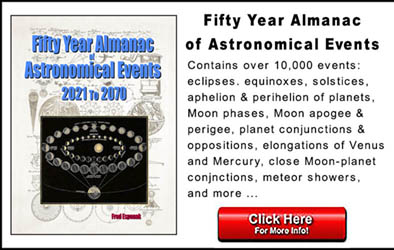
|

|

|

|

|

|

|

|

|
Acknowledgments
All eclipse predictions were generated on a Macintosh G4 PowerPC using algorithms developed from the Explanatory Supplement [1974] with additional algorithms from Meeus, Grosjean, and Vanderleen [1966]. The solar and lunar coordinates used in the eclipse predictions are based on the JPL DE405. The difference between Terrestrial Time (TT) and Coordinated Universal Time (UTC) used in these predictions is 69.184 seconds (= 32.184 seconds plus 37 leap seconds).
For lunar eclipses, the elliptical shape of the umbral and penumbral shadows were calculated using Herald and Sinnott (2014) method of enlarging Earth's radius to compensate for the opacity of the terrestrial atmosphere (including corrections for the oblateness of Earth).
All calculations, diagrams, tables, and opinions presented in this paper are those of the author, and he assumes full responsibility for their accuracy.
Permission is granted to reproduce the eclipse data when accompanied by a link to this page and an acknowledgment:
"Eclipse Predictions by Fred Espenak, EclipseWise.com"
The use of diagrams and maps is permitted provided that they are unaltered (except for re-sizing) and the embedded credit line is not removed or covered.
Footnotes
[1] UTC or Coordinated Universal Time is the primary time standard that regulates world clocks and time. It is based on International Atomic Time (TAI) with leap seconds added at irregular intervals to compensate for the slowing of Earth's rotation. Leap seconds keep UTC within 0.9 second of UT1 (UT1 is mean solar time at 0° longitude). UTC is not adjusted for daylight saving time. It is effectively a successor to Greenwich Mean Time (GMT).
[2] The instant of greatest eclipse for solar eclipses occurs when the distance between the Moon's shadow axis and Earth's geocenter reaches a minimum.
[3] Eclipse magnitude for solar eclipses is defined as the fraction of the Sun's diameter occulted by the Moon.
[4] Eclipse obscuration is defined as the fraction of the Sun's area occulted by the Moon.
[5] For solar eclipses, gamma is the distance of the Moon's shadow axis from Earth's center (in Earth radii) when it reaches its minimum absolute value.
[6] The Saros is a period of 6,585.3 days (18 years 11 days 8 hours) in which eclipses (both solar and lunar) repeat. The geometry isn't exact but close enough for a Saros series to last 12 or more centuries.
[7] The instant of greatest eclipse for lunar eclipses occurs when the distance between the Moon and Earth's shadow axis reaches a minimum.
[8] Umbral eclipse magnitude is defined as the fraction of the Moon's diameter occulted by Earth's umbral shadow.
[9] For lunar eclipses, gamma is the distance of the Moon's center from Earth's shadow axis (in Earth radii) when it reaches its minimum absolute value.
[10] Penumbral eclipse magnitude is defined as the fraction of the Moon's diameter occulted by Earth's penumbral shadow.
References
Chauvenet, W., Manual of Spherical and Practical Astronomy, Vol.1, 1891 (Dover edition 1961).
Danjon, A., "Les éclipses de Lune par la pénombre en 1951," L'Astronomie, 65, 51-53 (Feb. 1951).
Espenak, F., Meeus, J., Five Millennium Canon of Solar Eclipses –1999 to +3000, 2nd Edition, AstroPixels Publishing, Portal, AZ, 2021.
Espenak, F., Meeus, J., Five Millennium Canon of Lunar Eclipses –-1999 to +3000, 2nd Edition, AstroPixels Publishing, Portal, AZ, 2021.
Espenak, F., Thousand Year Canon of Solar Eclipses 1501 to 2500, AstroPixels Publishing, Portal, AZ, 2014.
Espenak, F., Thousand Year Canon of Lunar Eclipses 1501 to 2500, AstroPixels Publishing, Portal, AZ, 2014.
Espenak, F., 21st Century Canon of Solar Eclipses, AstroPixels Publishing, Portal, AZ, 2016.
Espenak, F., 21st Century Canon of Lunar Eclipses, AstroPixels Publishing, Portal, AZ, 2020.
Espenak, F., Atlas of Central Solar Eclipses in the USA, AstroPixels Publishing, Portal, AZ, 2016.
Explanatory Supplement to the Astronomical Ephemeris and the American Ephemeris and Nautical Almanac, Her Majesty's Nautical Almanac Office, London, 1974.
Herald, D., and Sinnott, R. W., “Analysis of Lunar Crater Timings, 1842–2011,” J. Br. Astron. Assoc., 124, 5, 2014.
Hire P. de la, Tabulae Astronomicae, Paris, 1687.
Keen, R. A., "Volcanic Aerosols and Lunar Eclipses", Science, vol. 222, p. 1011-1013, Dec. 2, 1983.
Meeus, J., Elements of Solar Eclipses 1951-2200, Willmann-Bell, Richmond, VA (1989).

